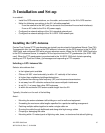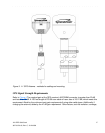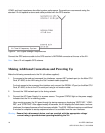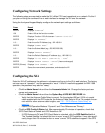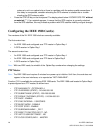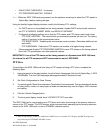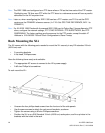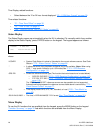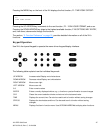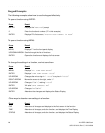
XLi IEEE 1588 Clock 21
997-01510-03, Rev. C, 12/12/2006
2
5
1
SSSSSSSSSSSS SSSSSSSSSS SSSSSSS S SSS S SSSSS S
• SLAVE SYNC THRESHOLD - 5 microsec
• PTP PREFERRED MASTER - DISABLE
Note: When two IEEE 1588 cards are present, use the up/down arrow keys to select the PTP master in
Option Bay 4 before making changes.
Using the familiar keypad display interface, modify the following F131 settings:
• If a DHCP server is not available on the timing network, disable DHCP and set static values for
the PTP IP ADDRES, SUBNET MASK, and DEFAULT GATEWAY.
1
• Configure the following settings on so that the PTP master and PTP slaves match each other:
- PTP SYNC INTERVAL - The rate at which synchronization packets are sent out. The factory
setting, 2 seconds, is the recommended value.
- PTP BURST MODE - Enables quick and accurate synchronization. Generates additional net-
work traffic.
- PTP SUBDOMAIN - Defines the PTP master as a member of a logical timing network.
• (Recommended) Enable PTP PREFERRED MASTER to have PTP slaves on the timing network
favor the PTP grandmaster over other potential masters.
IMPORTANT: If one of the PTP slaves on the timing network is a Symmetricom IEEE 1588 card,
the interval for all PTP masters and PTP slaves must be set to 2 SECONDS.
PTP Slave
To reconfigure the IEEE 1588 card from being a PTP master to being a PTP slave, complete the
following steps:
1. Having logged in to the web interface, from the Admin Homepage, click the link Option Bay 4 IEEE
1588 Master. The new 1588 web page takes approximately 5 seconds to load.
2. Set Clock Configuration to Slave Primary.
3. Try operating with Slave Synchronization Threshold at 5 microseconds. Timing networks with bursty
or heavy traffic, routers, or many layers of hubs and switches may need the higher 1000 microsec-
ond setting.
4. Click the Submit Changes button.
5. The front panel display should show "LOCKED PTP PRI" soon after.
The IEEE 1588 card is now operating as a PTP slave and is also functioning as the primary reference
source to the PTP master. The GPS receiver, which was previously operating as the primary reference
source to the IEEE 1588 clock, is now a STANDBY reference source.
1. After saving changes, if DHCP is enabled and a DHCP server is available, F131 displays the DHCP-assigned set-
tings following the PTP DHCP ENABLE screen.





